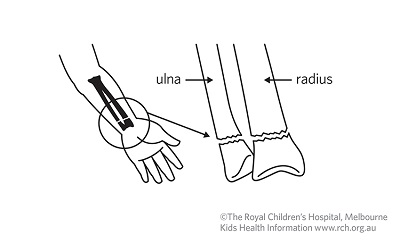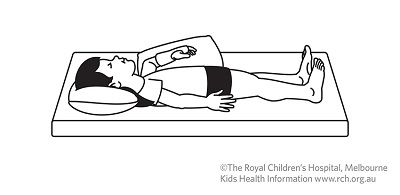Wrist fractures are common injuries in childhood. There are two bones in the forearm – the radius and the ulna. In a wrist fracture, one or both of these bones may be broken.

Sometimes the bones may need to be put back into position by a doctor or nurse practitioner in the emergency department or operating theatre, or your child may need surgery.
Your child will need a cast to support and protect the bones while the fracture heals. It is important to care for your child’s wrist and cast correctly after you leave hospital.
This fact sheet provides information on what to do once your child has been treated in hospital for a wrist fracture. If you think your child has a fracture and you are looking for first aid advice, see our fact sheet Fractures (broken bones).
Care at home
Fractures are painful. Although immobilising the arm with a cast will help to reduce the pain, additional pain relief (e.g. paracetamol) is often needed. Give the pain relief medication regularly for the first few days, following the directions on the packet, or as directed by the doctor.
Elevate the wrist
During the first two days and nights it is important for your child to rest and elevate their wrist above heart level to minimise swelling. From the third day, it is only necessary to elevate the wrist overnight.

Use an arm sling for the first week, making sure the fingers are above the level of the elbow.
Encourage your child to bend and straighten their fingers regularly, and make sure you check their fingers for movement, feeling and circulation.
Skin care
Itching under the cast is common. Make sure your child avoids scratching inside the cast as this may damage the skin and cause infection. Do not let them push any object inside the cast (e.g. don’t allow them to use a ruler to scratch inside the cast). Never cut or attempt to modify
the cast.
You can help relieve itch by using a hair-dryer to blow cold air into the cast (do not use warm or hot air as this can burn the skin or warp the cast). Antihistamines may be useful for reducing the itch. Talk to your local pharmacist about a suitable antihistamine medication to use.
Cast care
If your child has a plaster cast, it is important to keep the cast clean and dry. For showering or bathing, seal the cast in a plastic bag with tape or a rubber band. Never allow your child to immerse the cast in water, even if it is in a plastic bag. For more information, see our fact sheet
Plaster cast care.
Even though fibreglass casts are waterproof, you need to make sure the padding underneath stays dry. If your child has a fibreglass cast, treat it as though it is a plaster cast and avoid getting it wet.
When to see a doctor
Severe pain and swelling, change in the colour of the fingers (white or blue), numbness or pins and needles, and inability to move the fingers are signs that the arm has not been elevated for long enough or that your child’s cast may be too tight. If any of these signs occur, rest and
elevate the arm above heart level for 30 minutes.
After elevating the arm for 30 minutes, take your child to the hospital emergency department immediately if:
- the fingers remain very swollen
- the fingers remain white or blue
- your child complains of pins and needles or numbness in the fingers
- your child is not be able to move their fingers, or complains of pain when you move them
- your child has severe pain that is not relieved by the recommended medication at the recommended dose.
Take your child to your GP or local hospital if:
- the cast is cracked, soft, loose or tight, or has rough edges that hurt
- you are worried that an object has been pushed inside the cast
- there is a bad smell or ooze coming from the cast
- your child is in increasing pain.
Follow-up
Your child will usually need to have an X-ray and review five to seven days after they injure their wrist. The cast will not need to be removed for this X-ray. The doctor will tell you when your child should have their follow-up appointment.
The cast will be able to be removed once your child's fracture has healed.
After the cast is removed
When the cast is removed, the skin may be dry and itchy. Bathe with warm water and soap, and apply a gentle, non-perfumed moisturiser.
The wrist may be stiff when the cast first comes off, but children normally regain wrist movement and strength by using the arm for gentle activity and play. Physiotherapy is not often required.
Your doctor will give you specific advice regarding your child’s return to sport, which in most cases may be resumed four to six weeks after the cast is removed. If your child required surgery, full contact sports should be avoided for two to three months.
Take your child to the doctor if:
- they still experience pain in their wrist
- you are concerned about the shape of your child’s wrist
- your child has problems with the way they use their wrist and hand.
Key points to remember
- In a wrist fracture, the radius and/or the ulna may be broken.
- It is important to care for your child’s wrist and cast correctly.
- Your child should elevate their wrist for the first two days and nights after the injury.
- Ensure your child avoids scratching inside the cast and do not let them push any object inside the cast.
- Seek urgent medical attention if after elevating the arm for 30 minutes your child still shows signs that the cast is too tight.
- Follow your doctor’s advice about returning to sport after the cast has been removed.
For more information
Common questions our doctors are asked
Will my child’s fractured wrist always be weaker than the
other wrist, even after it has healed?
Once the fractured bone has fully healed in the correct
position and alignment, then there is no residual weakness of the bone. It may
take some time for the muscles to regain their strength, if the arm has been
immobilised in a cast, but once this occurs, your child will return to their
normal strength and ability.
Do the follow-up appointments need to be at the hospital
where my child was originally treated?
No
– you can have your follow-up appointments at a local hospital or medical
centre that is equipped to manage fractures. Your doctor will be able to help
you find an appropriate place for a follow-up appointment.
Developed by The Royal Children's Hospital and the Victorian Paediatric Orthopaedic Network. We acknowledge the input of RCH consumers and carers.
Reviewed November 2018.
This information is awaiting routine review. Please always seek the most recent advice from a registered and practising clinician.
Kids Health Info is supported by The Royal Children’s Hospital Foundation. To donate, visit
www.rchfoundation.org.au.